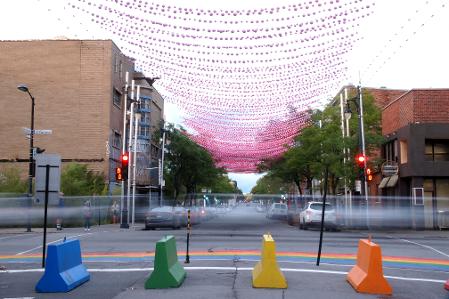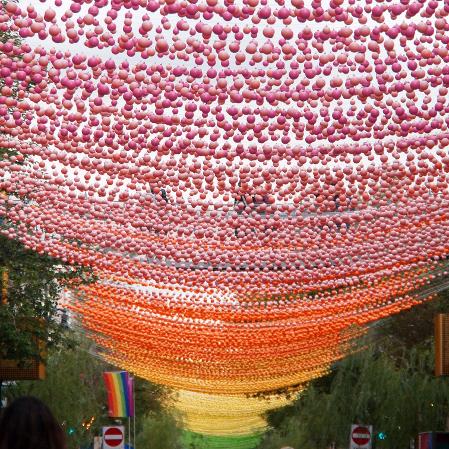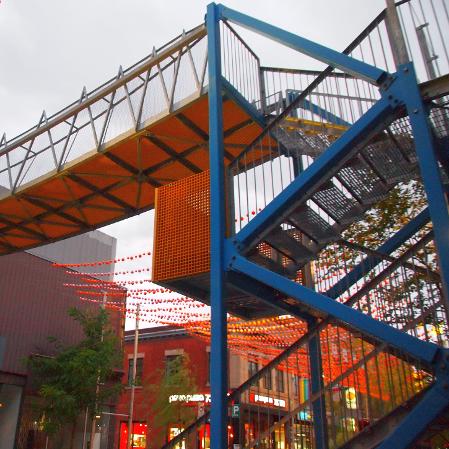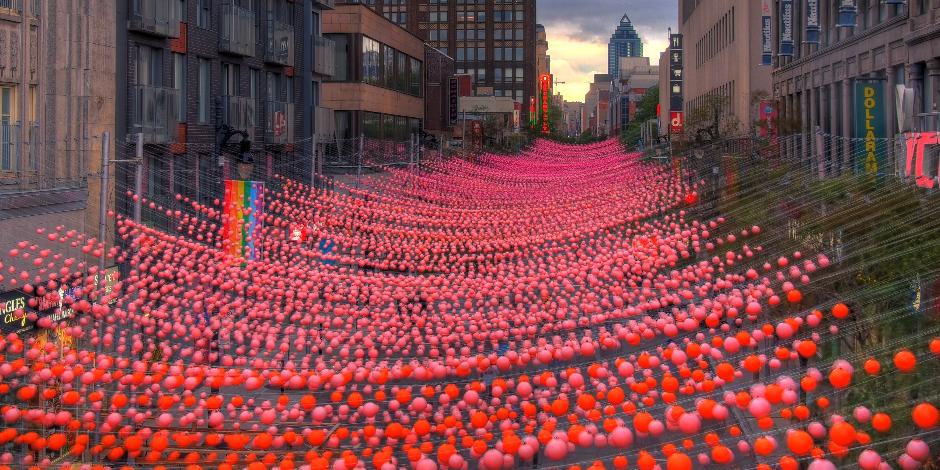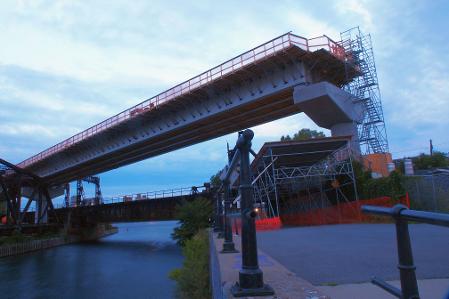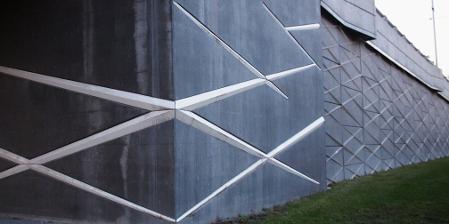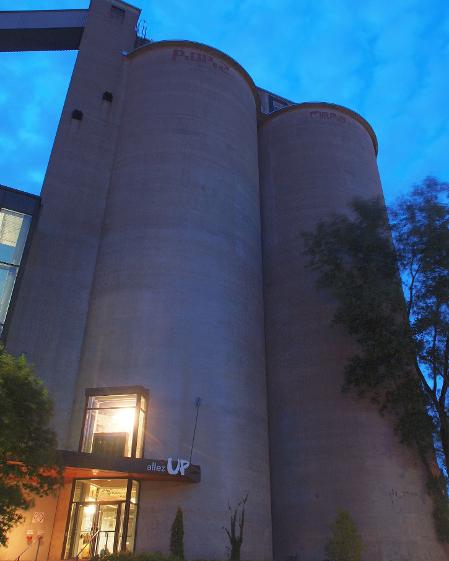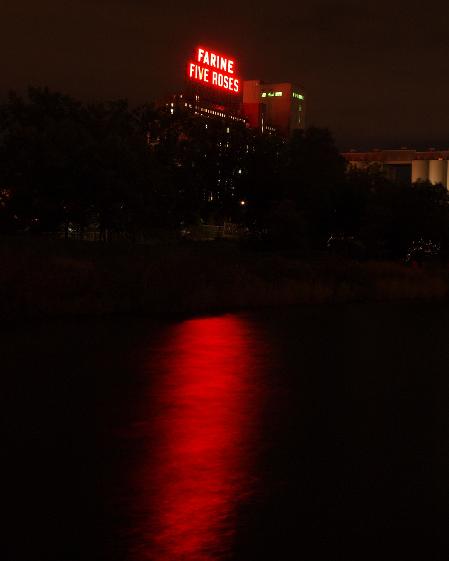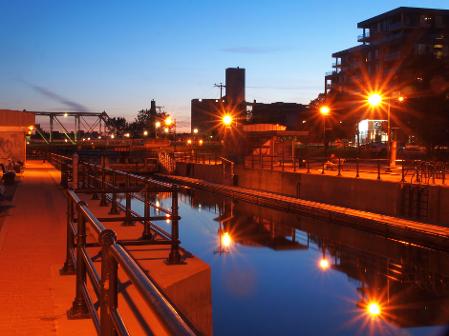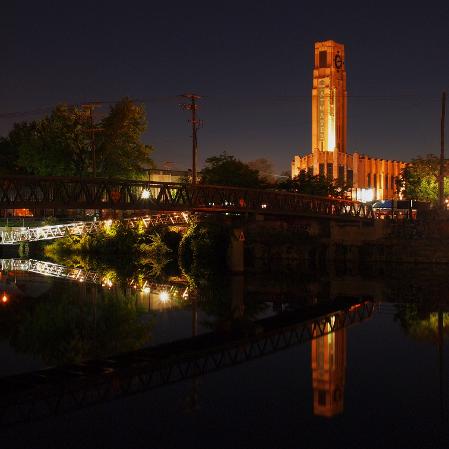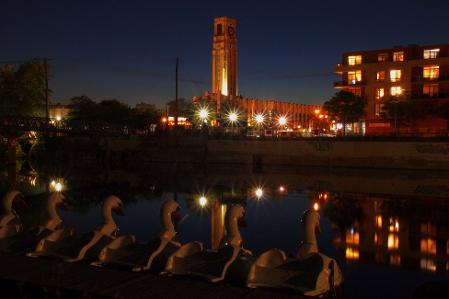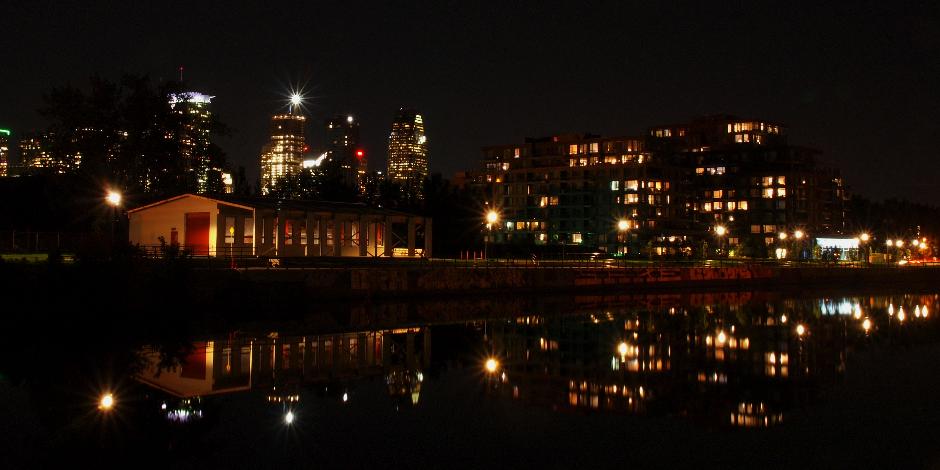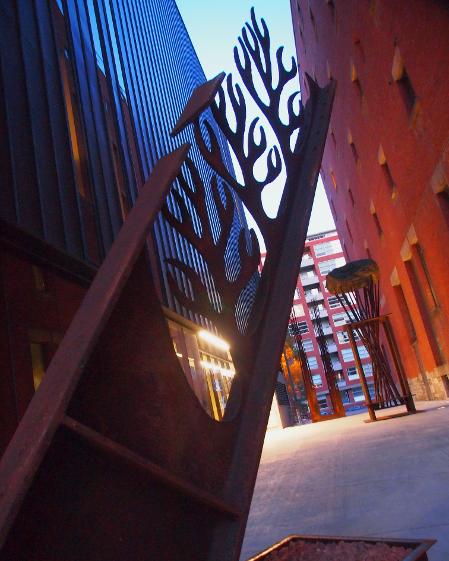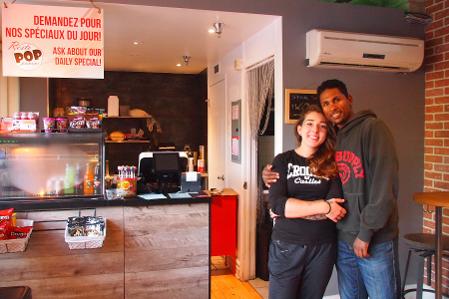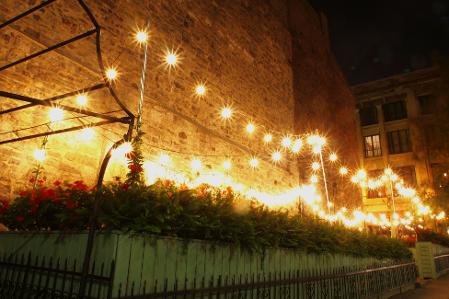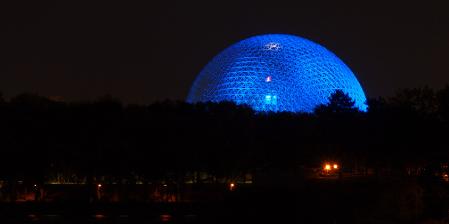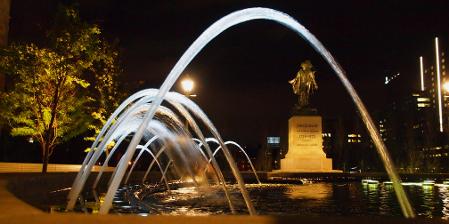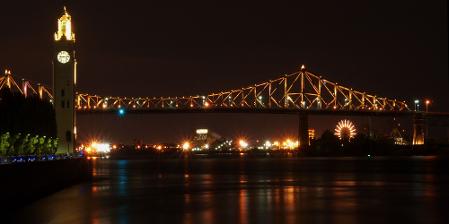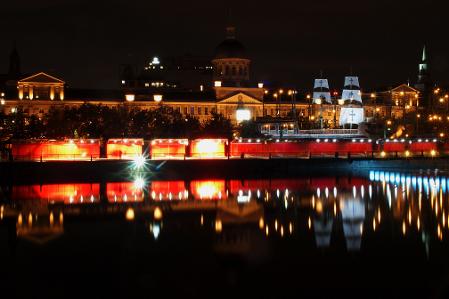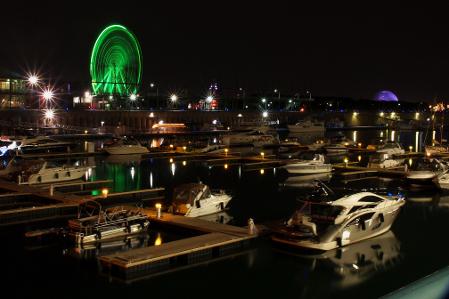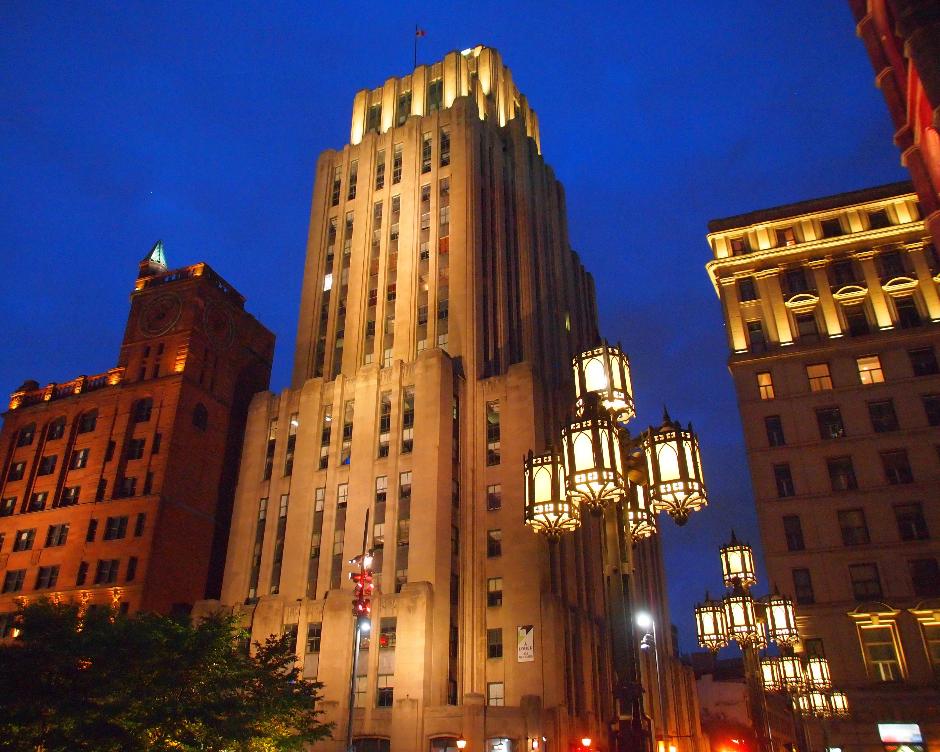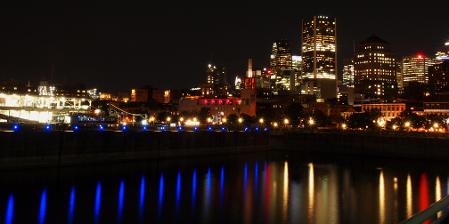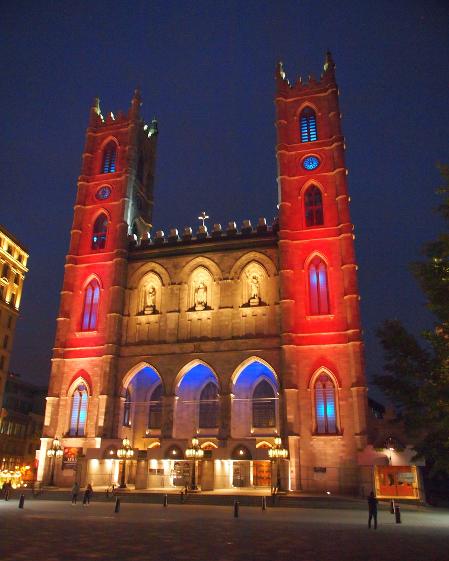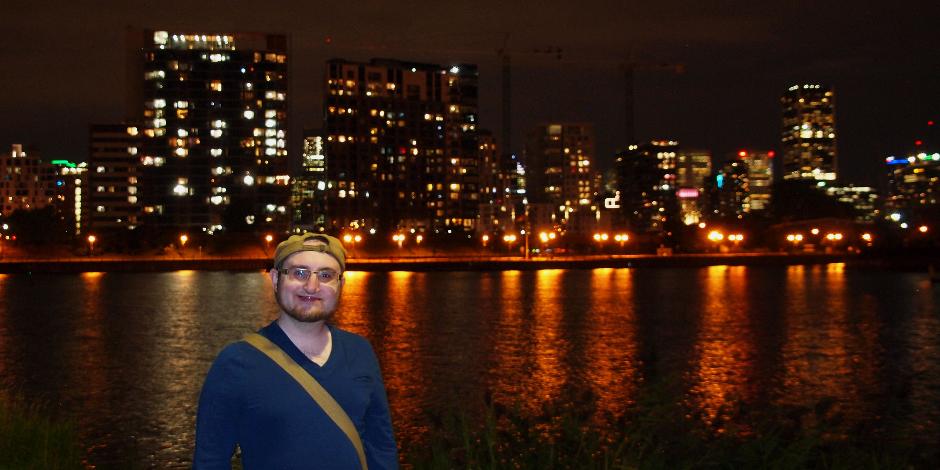Bon Soir Et Au Revoir
On September 27, 2019 I had to say good night and goodbye to Montréal. Before that happened I made sure to get around four hundred evening and nighttime pictures. Here are my favourites.
We begin with a walk down Sainte-Catherine Street, underneath the largest piece of public art I have ever seen. It was called 18 Shades Of Gay. It consisted of thousands of coloured balls, like Christmas ornaments, arranged in a rainbow that stretched for a whole kilometer. I was lucky to see it when I did; this was its last Summer. Next year, some new art initiative will be implemented. The strings of balls are being sold.
Olympus E-PL1: f22, 1 sec, ISO 100
IrfanView: Crop, Colour Balance
Throughout the Village, Sainte-Catherine is pedestrian-only during the Summer. In most places it is blocked by large cement planters, but at one cross street highway barriers are used. Entertainingly, they are painted rainbow-style. There was also a suspended bridge from which one could get an overview of the Shades.
Olympus E-PL1: f56.6, ISO 200 // PhotoMatix: HDR Toning.IrfanView: Crop, Colour Balance
This nifty retaining wall holds up part of the Boulevard Henri-Bourassa, a major traffic artery. I was not a fan of crossing that street thanks to its great width, but the retaining wall is snazzy.
Olympus E-PL1: f22, 4 secs, ISO 200
IrfanView: Crop, Colour Balance
Olympus E-PL1: f4.1, 1/60 sec, ISO 1000
IrfanView: Crop, Colour Balance
This bridge did not exist when I first arrived. Now, it spans the Lachine Canal. It is part of the REM, the light-rail project I worked on during my term in the city. My apartment was not far from it, so in addition to hearing about it at work, I also got to see the new bridge in person from time to time.
The wheat elevators are icons of the Lachine Canal. So, too, is the Farine Five Roses sign that blinks out from atop some of them. A few of the elevators are still used for their built purpose, many have fallen into neglect, and at least three have found new lives. Allez Up is a climbing gym built into one set.
Olympus E-PL1: f22, 30 secs, ISO 125
IrfanView: Crop, Colour Balance
Olympus E-PL1: f16, 60 secs, ISO 200
IrfanView: Crop, Colour Balance
Much like the Rideau Canal in Ottawa, the Lachine Canal is mostly recreational these days. Like the Rideau, it too has several locks.
Olympus E-PL1: f22, 60 secs, ISO 160
IrfanView: Crop, Colour Balance
To walk the entire length of the Lachine Canal would take more hours and more granola bars than I had available. Still, I did make it as far as Atwater Market, which was about four kilometers away. The stroll along the side of the Canal was very peaceful, though not solitary. The path is used by runners, dog-walkers, pram-pushers, and electric-scooterers. Some people even stand and fish in the waters of the Canal. There are mostly businesses clustered near the banks, but also an ever-growing number of condominia in the Griffintown neighbourhood. At one point, I saw an illuminated, sandy park with "beach" volleyball nets set up. It was well used, even late into the evening.
Olympus E-PL1: f22, 60 secs, ISO 160 // IrfanView: Crop, Colour Balance
Another essential ingredient to Montréal is the amazing restaurants, like Resto Pop Panini. Sarah the chef always has something tasty on the menu, and Stefano the proprietor is one of the best conversationalists I have ever met.
Olympus E-PL1: f4, 1/15 sec, ISO 1600
IrfanView: Crop, Colour Balance
Olympus E-PL1: f4, 1/60 sec, ISO 1250
IrfanView: Crop
More art! This building features three large pieces in the alleyway leading to the main door. The big rock suspended on metal tubes was impressive, but my favourite was the I-beam cut into a trio of fronds or bushes.
The alleyway art and Resto Pop Panini were both not far from my apartment. I am not sure in which neighbourhood it counted. Found at the crux of Griffintown, the International Quarter, and the Old Port, it was exceptionally located for getting to see those very distinct districts.
With the exception of the very last photo, the rest were taken in the Old Port. It is a lovely spot filled with historic buildings. There are also some more modern bits located on the quays themselves. The Old Port also offers some excellent views of the high-rises of the downtown core and also the brightly-illuminated rides of La Ronde.
Olympus E-PL1: f22, 60 secs, ISO 100
IrfanView: Crop, Colour Balance
This fountain is located not far from City Hall. The jets of water change height periodically. In 1858 a statue of Neptune was put in a fountain. That was changed out in 1930 for the current statue of Jean Vauquelin, a French naval captain who served in the defense of Louisbourg during the Seven Years' War. So, he has as much to do with Nova Scotian history as that of Quebec!
Olympus E-PL1: f22, 60 secs, ISO 125
IrfanView: Crop, Colour Balance
Perched on the edge of a pier not far from the Jacques Cartier Bridge is the Old Port Clocktower. At night the tower is illuminated, sometimes with the ghostly image of a woman.
The Jacques Cartier Bridge is also lit. Little lights glimmer up and down the structure, like ants that shine in many colours. Apparently it is meant to function as a calendar, using different colours based on the time of year. Alas, the bridge lighting was extremely expensive and remains controversial to this day.
Olympus E-PL1: f4.2, 1/10 sec, ISO 1600
IrfanView: Crop, Colour Balance
The Biosphere, as seen from one of the quays in the Old Port. The lights playing across the geodesic structure change colour every so often.
Olympus E-PL1: f22, 60 secs, ISO 125
IrfanView: Crop, Colour Balance
To see any photograph in more detail, just give it a mouse-click! It should open in a new window. If nothing happens when you do that, try right-clicking and selecting "open link in new tab" from the menu.
Olympus E-PL1: f22, 60 secs, ISO 100
IrfanView: Crop, Colour Balance
With a sixty-second exposure it looks like the Grande Roue (The "Big Wheel") spins very quickly indeed! In actual fact it takes a leisurely pace. It offers views out toward the Biosphere and the marina on this side, and downtown and the Old Port on the other. Like the Biosphere, it has lights which change colour every few minutes. I also have pictures of it in blue and purple!
This shot shows Bonsecours Market, which has historical significance as a one-time meeting place of the Parliament of United Canada in 1849. Seen here in front of the large building is Voiles En Voiles, a sailing-ship themed aerial course for children. The kids scoot across ropes and obstacles between two ships at two or three storeys in the air. It looks like a ton of fun.
Olympus E-PL1: f22, 60 secs, ISO 125
IrfanView: Crop, Colour Balance
Olympus E-PL1: f4, 1/15 sec, ISO 1600 // IrfanView: Crop, Colour Balance
Above is the Aldred Building. It was one of the city's first skyscrapers... Though at 23 storeys it does not exactly fit that definition today! The Art Deco gem has the same style of setbacks seen in the Empire State Building. Both edifices were completed in 1931.
Located on the same square as the Aldred Building is the Notre Dame Basilica. It is over a century older than the office tower, having started construction in 1824. It replaced a smaller church which was built in 1672. The architect who designed it is the only person buried in its crypt. He converted to Catholicism not long before he died. According to legend, that was so he could be buried inside his oeuvre.
During the day the Basilica has a fairly standard grey appearance. At night it is lit with a variety of bright colours.
Olympus E-PL1: f22, 60 secs, ISO 160
IrfanView: Crop, Colour Balance
Olympus E-PL1: f4.1, 1/10 sec, ISO 1600
IrfanView: Crop, Colour Balance
This view of the downtown core is seen from the quay containing the Montréal Science Centre.
Below is a shot from along the Lachine Canal. I managed to sneak myself into the frame thanks to a camera timer... And quiet a few snapshots of trial and error! I thoroughly enjoyed my time in Montréal, and hope to visit again someday.

